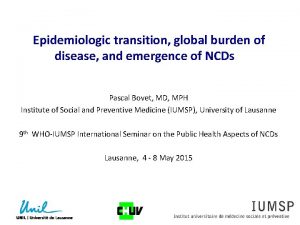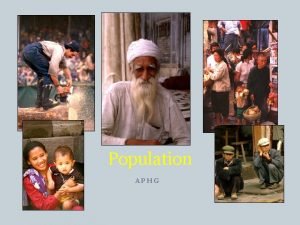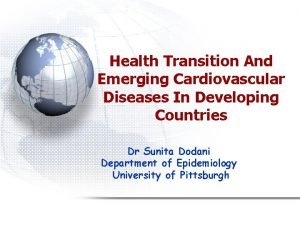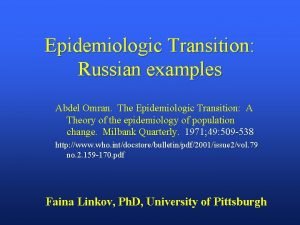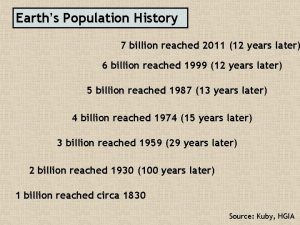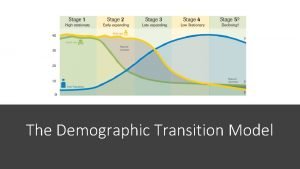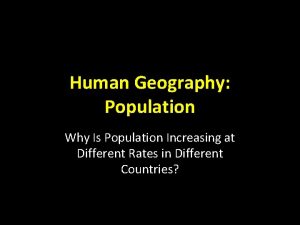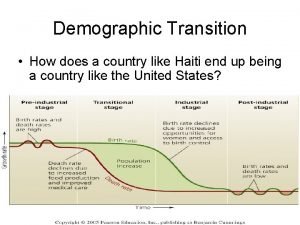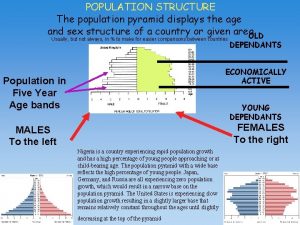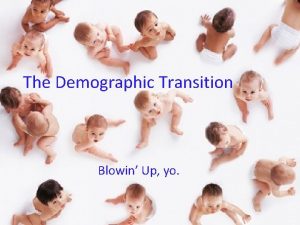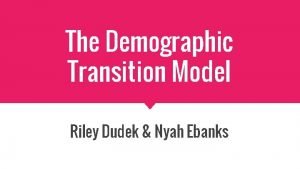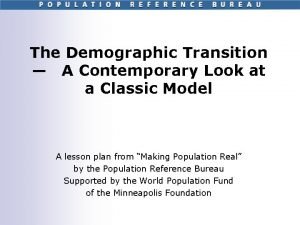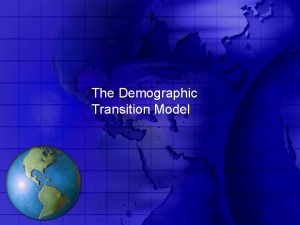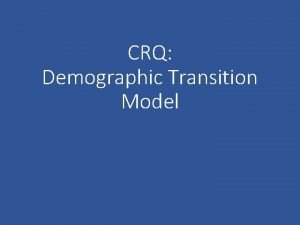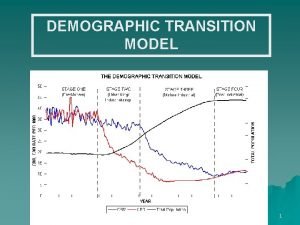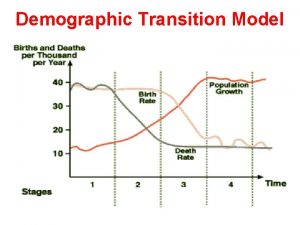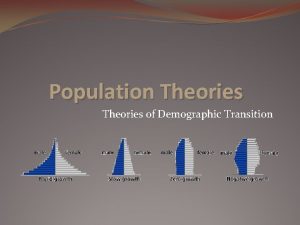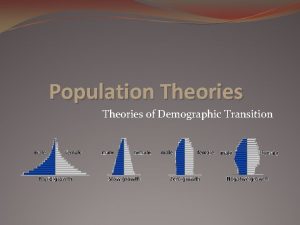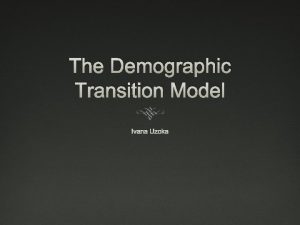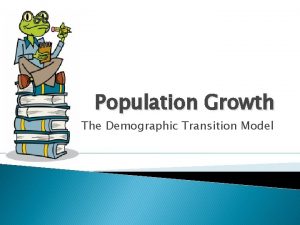Demographic and Epidemiological Transition Models Demographic Transition Model





















- Slides: 21

Demographic and Epidemiological Transition Models

• Demographic Transition Model: Warren Thompson 1929 • Epidemiological Transition Model Abdel Omran 1971

Stages in Classic 4 -Stage Demographic Transition Model (DTM) (Some books show a 3 -stage model; others mention a new 5 th stage)

Stage 1: “Pre-Industrial” High birth rates and high death rates (both about 40) Population growth very slow Agrarian society High rates of communicable diseases Pop. increases in good growing years; declines in bad years (famine, diseases) No country or world region still in Stage One

Stage 2: “Early Industrial” High birth rates (over 30) but death rates decline (to about 20) RNIs increase sharply (pop. explosion); growth rate increases thruout Stage Two Growth not from increase in births, but from decline in deaths MDCs = starts early 1800 s LDCs = starts after 1950 s

TRANSITION TO STAGE TWO IN CLASSIC DTM Known as the Epidemiologic Transition Agricultural technology Improvements in food supply: higher yields as agricultural practices improved in “Second Agricultural Revolution” (18 th century) In Europe, food quality improved as new foods introduced from Americas Medical technology Better medical understanding (causes of diseases; how they spread) Public sanitation technologies Improved water supply (safe drinking water) Better sewage treatment, food handling, and general personal hygiene Improvements in public health especially reduced childhood mortality

Declining Infant Mortality Rates

When IMR declines, fertility rates drop soon after

Stage 3: “Later Industrial” Birth rates decline sharply (to about 15) Death rates decline a bit more (to about 10 or less) Note growth still occurs, but at a reduced and declining rate MDCs = starts in late 1800 s LDCs = starts after 1980 s* * Or hasn’t started yet

TRANSITION TO STAGE THREE IN CLASSIC DTM Known as the Fertility Transition Societies become more urban, less rural Declining childhood death in rural areas (fewer kids needed) Increasing urbanization changes traditional values about having children City living raises cost of having dependents Women more influential in childbearing decisions Increasing female literacy changes value placed on motherhood as sole measure of women’s status Women enter work force: life extends beyond family, changes attitude toward childbearing Improved contraceptive technology, availability of birth control But contraceptives not widely avail in 19 th century; contributed little to fertility decline in Europe … Fertility decline relates more to change in values than to availability of any specific technology

Stage 4: “Post-Industrial” Birth rates and death rates both low (about 10) Population growth very low or zero MDCs = starts after 1970 s LDCs = hasn’t started yet Stage 5 (? ): Hypothesized (not in Classic DTM) Much of Europe now or soon in population decline as birth rates drop far below replacement level


Differences in DTM experience: MDCs & LDCs ● Faster decline in death rates — Tech improvements diffused from MDCs & applied rapidly in LDCs post-WW 2 ● Longer lag between decline in deaths and decline in births — Stage 3 slower start in LDCs where econ growth is delayed ● Higher max rates of growth in LDCs — Over 3. 5% peak RNI in Mauritius and Mexico; only 1. 3% peak in Sweden

Summary of DTM for LDCs Industrializing LDCs with some economic development follow DTM more closely; now in Stage Three. Most like MDCs in places where female literacy has increased the most. Lowest-income countries have high birth rates and deaths are leveling off at higher rates than DTM predicts (Stage Two). In some LDCs, death rates starting to increase (epidemics, worsening poverty)

The Epidemiological Transition Model

Stage I: Pestilence and Famine • Infectious and parasite diseases were principle causes of death along with accidents and attacks by animals and other humans. Thomas Malthus called these caused of death “natural checks” • Most violent Stage I epidemic was the Black Plague(bubonic plague or black death) probably transferred to humans by fleas from infected rats

Stage II: Receding Pandemics • Improved sanitation, nutrition, and medicine during the Industrial Revolution reduced the spread of infectious diseases. • Death rates did not improve immediately and universally during the early years of the Industrial Revolution. • Poor people who crowded into Industrial Cities had high death rates due to Cholera

Stage III: Degenerative Diseases • Associated with the chronic diseases of aging • Heart disease and cancer • Sub-Saharan Africa and South Asia have low incidences of cancer primarily because of low life expectancy.

Stage IV: Delayed Degenerative • Life expectancy of older people is extended through medical advances. • Cancer medicines, bypass surgery, better diet, reduced use of tobacco, and alcohol • However, consumption of non-nutritious food and sedentary behavior have resulted in an increase in obesity in this stage.

Stage V: Return of Infectious Disease • Return of Stage I diseases (Malaria, SARS, TB, AIDS) • Caused by: – Travel – Poverty – Evolution of microbes

 Epidemiological transition model
Epidemiological transition model Epidemiological transition model
Epidemiological transition model Demographic momentum ap human geography
Demographic momentum ap human geography Demographic transition
Demographic transition Epidemiological transition model
Epidemiological transition model Mickhail gorbachev
Mickhail gorbachev Dtm
Dtm Ernst ravenstein ap human geography
Ernst ravenstein ap human geography Uk demographic transition model
Uk demographic transition model Demographic transition model ap human geography
Demographic transition model ap human geography Chile demographic transition model
Chile demographic transition model Warren thompson geographer
Warren thompson geographer Haiti dtm stage
Haiti dtm stage Who created the demographic transition model
Who created the demographic transition model Ap human geography models and theories
Ap human geography models and theories Demographic transition model population pyramids
Demographic transition model population pyramids Demographic transition model worksheet
Demographic transition model worksheet Demographic transition model song
Demographic transition model song Herbicides definition ap human geography
Herbicides definition ap human geography Afghanistan demographic transition model
Afghanistan demographic transition model Demographic transition model example
Demographic transition model example Demographic transition model
Demographic transition model

